Orisha Oko: Yoruba Deity of Agriculture
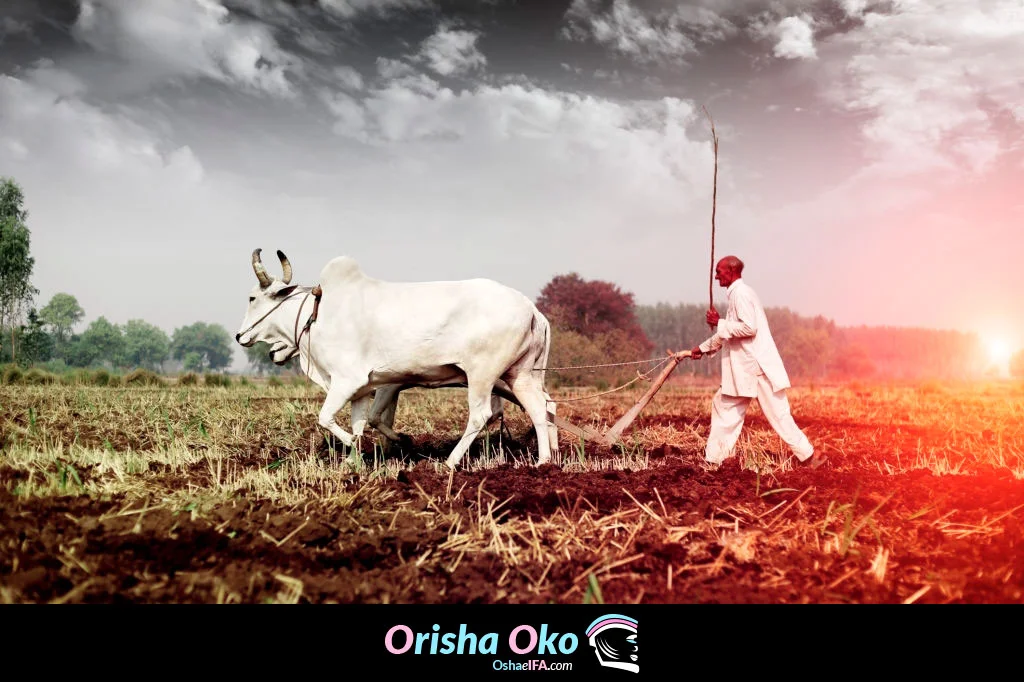
Within the Yoruba cosmology, Orisha Oko is the one who protects the crops and the plows. She is the deity of the field, the spirit of the earth, the farmer who feeds us with his crops. The infallible symbol of life because he contributes to the existence of the means to sustain us, encouraging us to obtain the necessary food to survive from the earth.
His name is an exact reference of his meaning and his power. According to the Yoruba language, the word "Orisa Oko" is interpreted as follows: Orisha refers to idol or deity; and Oko can mean both farm and penis. This means that its name refers to its connection with procreation and insemination as a symbol of fertility and reproduction, and its influence on the cycle of life.
His followers can also refer to Orishaoko as: the deity of the field, the spirit of the farm, agriculture or fertile land, the heavenly judge, or the King of the city of Irawo. Likewise, Adrián de Sousa in his book The Orishas in Africa, indicates that other names with which he is identified are:
«... Osoko, Orisa-Agba-Lagba-Irawo, Oroko, Oloosooko or Olorisa Ako, it is believed that its primitive name is Ayedjennov» (p.169).
In Cuba, his father is considered to be Obatalá and his mother Yembó; and in traditional customs, they agree that he has a special bond with Ogun, Shango, Obatala, Orunmila, and Koricoto. In addition, there are various legends that identify him as Olokun's husband, whose relationship ended in great conflicts, after he revealed his defects. However, they never managed to be completely separated, since the sea and the land always live together. In another of his avatars, he also had a loving relationship with Yemaya.
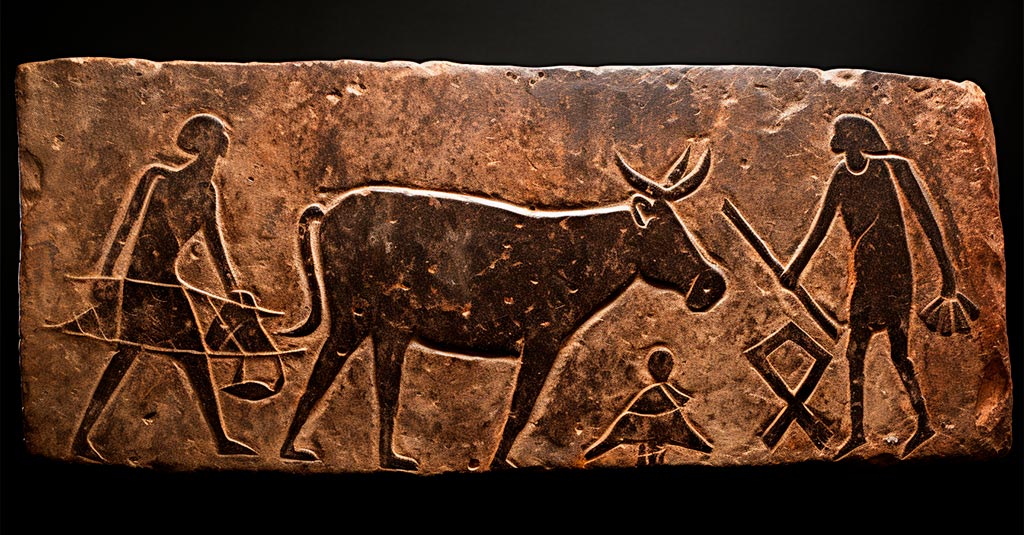
Being directly responsible for prosperity on earth, one of the living beings that is its best ally and messenger are bees, whose work is essential to maintain the ecological balance in nature and, therefore, for human existence to be sustainable. Without pollination, agricultural yields would be threatened, with some fruits disappearing and considerably damaging food sources. This is an example of how fundamental Orishaoko is for subsistence.
“It is said that when bees fly over the head of a devout person, it is signaling that they are going to bring happiness and prosperity. The bees, as organized workers and as a symbol of wisdom, embody in the devotees of the Orisha those qualities of the Orisha's character. But also, bees help pollinate, that is, transport pollen from plants and flowers through the fertile field. (p.70).
Shango Omo Asa. Orisha's power. 2021.
Orishaoko represents the cycle of life itself. Life and death. That is why it is said that she has two personalities that emerge as the day goes by. While the sunlight shines, he presents himself as a pure and upright man, but as night falls he is transfigured, turning into a grimace, which some point out is Ikú (death).
As its energy lives in the earth (especially in the plowed, sown and harvested land), it is also attributed the work of receiving the corpses that are delivered to it by the Orisha Yewá. That is, just as he feeds the living, after his death all beings return what they received by feeding the earth. It is from this power that his ability to appease Ikú is born, and to get a person who is about to die to be forgiven, through the appropriate works (feeding the earth with the corresponding food and animal sacrifices).
On the other hand, due to its active participation in the productive dynamics that supplies food to living beings, it forms an important trilogy with the Oshas: Oke and Oggue, who, in turn, are also responsible for the harvests, the rains, the fire inside the Earth, and the animals.
Regarding your story, Yoruba customs indicate that Orisha Oko was the founder of the city of Irawo. Before that, he was a hunter. But, upon settling down, he dedicated himself to cultivating the land with the help of his good friend Oggun, who made him an iron plow that made his work easier.
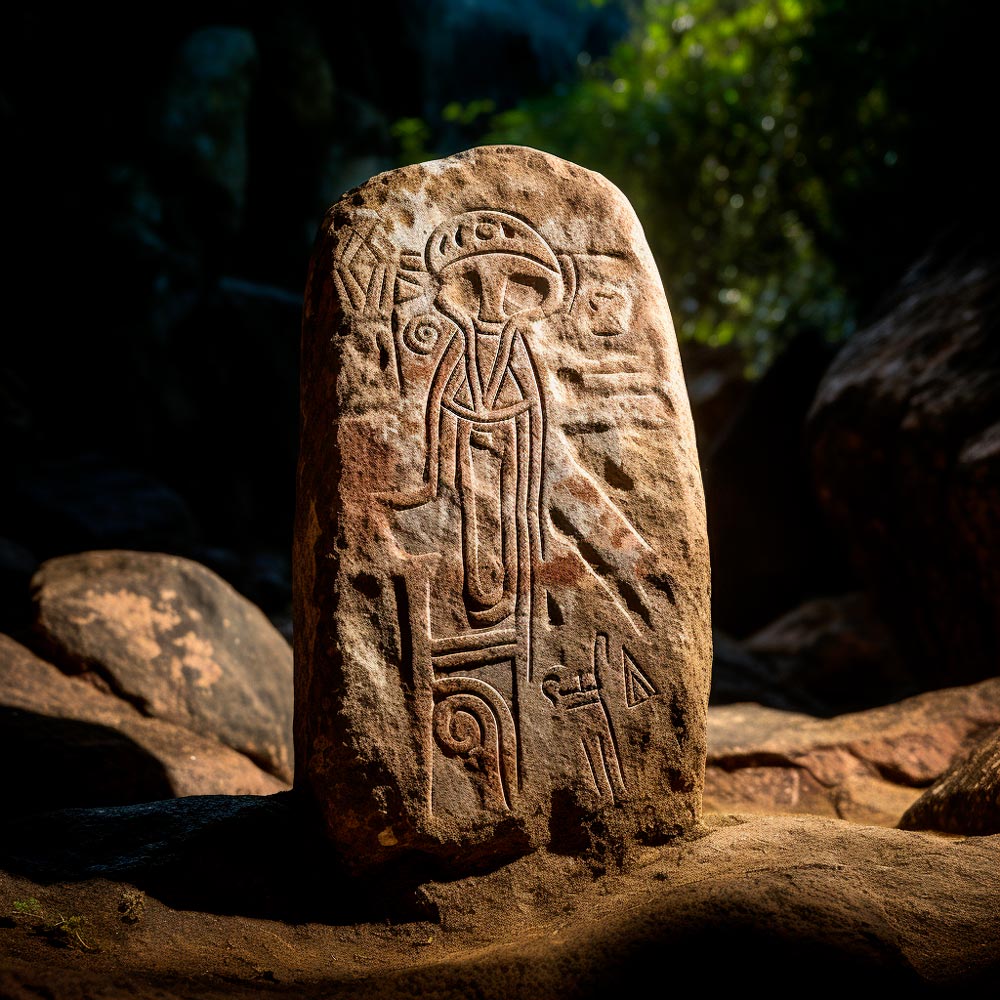
Tradition indicates that after collecting his first harvest, he broke a taboo that would bring him serious consequences. He ate the first ishu (yam) that belongs to mother earth and that was to be offered in a special ceremony.
The consequences of his actions were terrible, he ended up getting leprosy, being banished from the city, in the company of his wife. They settled in the forest, where they discovered the power of seeds for planting and the healing capacity of herbs, to such an extent that they recovered their health and returned to Irawo to share their knowledge for the benefit of all. Regarding this passage, Shangó Omo Asa (2021) recounts that:
«Even after death they were not forgotten, and those who knew them and used their knowledge began to call them: those who entered the bosom of the earth to continue another existence. This is the reason for the common saying among the Yoruba: Orisaoko wole Irawo, which means Orishaoko entered the bosom of the earth in the town of Irawo». (p.72).
The central role of Orishaoko in Santeria and its particular characteristics
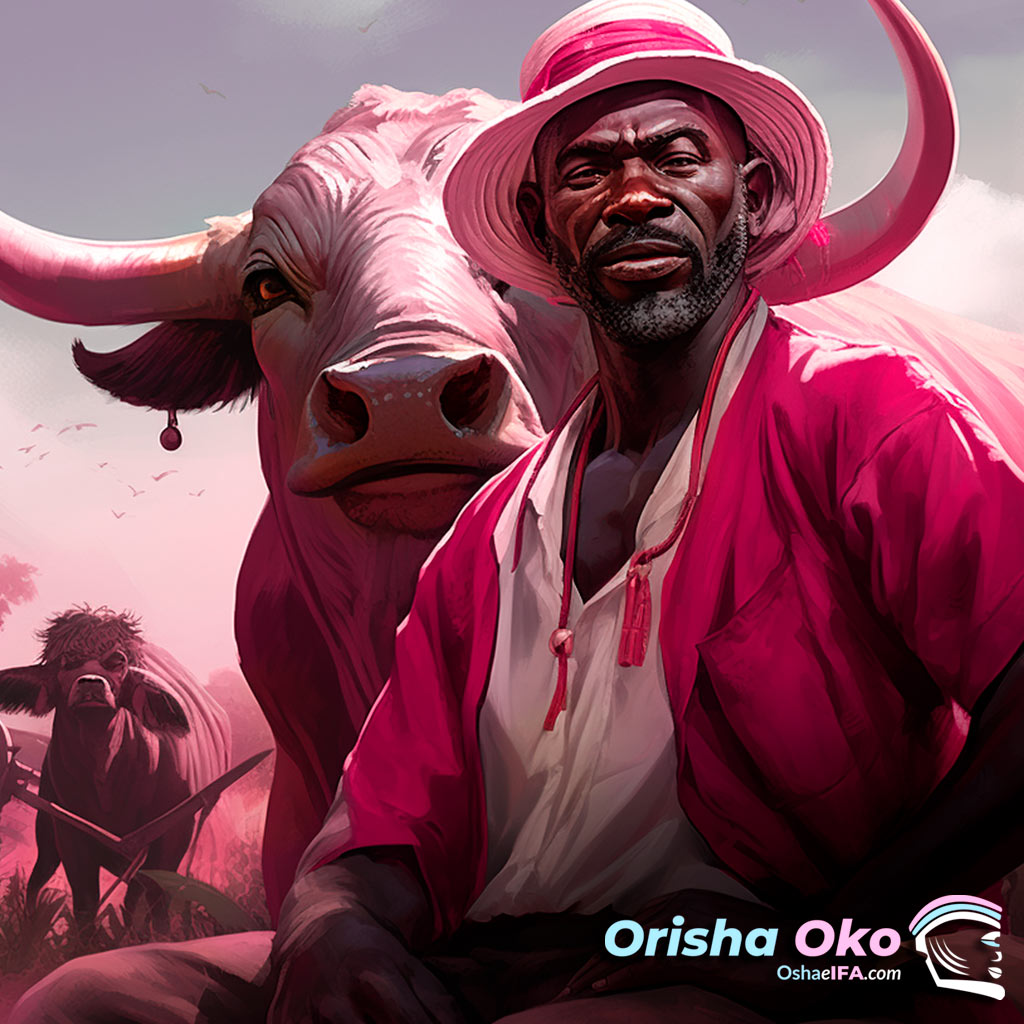
In humans, this deity symbolizes willpower. She represents fertility, fertilization, stability, permanence, perseverance, firmness, survival, strength, the cycles of nature, agriculture and intense and lasting feelings.
He is the patron of farmers, but he is also considered the arbiter of all disputes, especially when it comes to conflicts in which women are involved. He is even credited with the power to be the judge in the trials of the Orishas.
If we wanted to physically identify, What is Orisha Oko like? The most logical thing to do would be to recreate him as a man with strong arms, with the typical features of a farmer, with his respective straw hat (characteristic acquired in Cuba), skin tanned by the sun and driving two oxen with which he plows the land to deposit the seeds with which it feeds living beings.
Regarding his personality, it is estimated that he is very industrious and discreet, that he knows how to keep secrets deeply, and that he has great abilities for consultation and divination.
As for the the colors that identify Orisha Oko, the main ones are red and white. The red color was given to him by the Orisha Shango with whom he has a special relationship and represents the circulation of blood that does not stop, just as the cycle of life does. The white, on his part, was granted to him by Obatala, and represents the essence of semen, with which he carries out his main mission, which, as already mentioned, is fertilization.
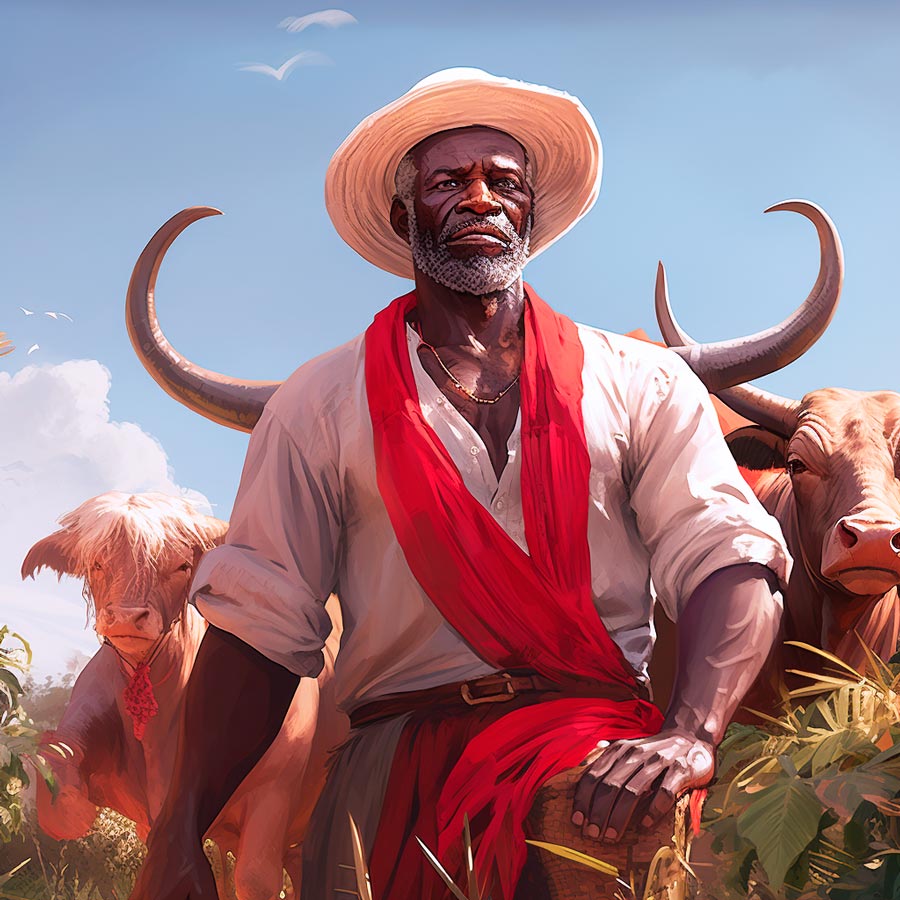
In fact, within traditional practices, those consecrated in their cult usually paint a red and white vertical line on their forehead in allegory of their consecration. However, in Afro-Caribbean customs, their necklaces are made with pink or lilac beads and quite pale turquoise blue, sometimes they are decorated with corals or white beads striped with red are incorporated.
Within the worship of Orishaoko, the Yoruba peoples celebrate annual festivals that acclaim his influence on the crops. In Nigeria, the "Iwa Ji" festival is held, which represents the commemoration of the new yam, announcing the end of the harvesting of the fruits of the earth and the beginning of a new sowing cycle. In general, it is carried out between the months of June or July. In Cuba, due to practices inherited from syncretism, the diaspora established that His day is celebrated on May 15., and with respect to the week, the days correspond to Monday.
It has become clear that this saint represents prosperity in every way. Therefore, when analyzing What is asked of Orishaoko? It is observed that his devotees often make requests to achieve abundance and stability, through fruitful work; in times of drought, he is implored to help send the rain, or stop it in times of strong weather conditions; he is asked to improve health states and avoid premature death; It is also appropriate in conflict situations, where mediation and dispute resolution are required; and of course, it influences in a favorable way to conceive children. Fundamentally, it is an Orisha that is invoked and received to attract stability in both health and productivity.
The Odu Isalaye of Orisha Oko (Ifa sign in which he descends to Earth) is Iwori Bode. The treaty of that sign explains how the cult of this Orisha arose in the city of Rawo (near Oyo), and the recommendations that, he himself indicated, that his devotees and consecrated people should follow to entertain him and achieve his blessings, as described sets below:
«Every man who wants to practice my cult and place himself within my descendants (become part of the Oko clan) must offer yams and take them to the house of Ja Osa (priest of Orisha Oko, whose name means ) the two tips of the roots soaked in oil. The Ja Osa must put a part of the offering on the lid of the gourd, in which the four pieces of kola will already be, and a part of this offering of yams. All those who want to consecrate themselves to my cult should not eat yams from the new harvest, until three months after having brought them to the house of Ja Osa and his family. On the first day of the offering, the Ja Osa will sacrifice a guinea fowl on the gourd where the kola is found, he will run the blood over the gourd and mix it with the pieces of kola nut. After this, everyone will drum and dance. My descendants who wish to have children must come with offerings to Ja Osa's house and implore me during this time. Every child born after these offerings and these prayers must bring me a sacrifice every year, because he will be my son, even though his parents already belong to my clan." (Odu of Ifa: Iwori Bode).
How is Orisha Oko enshrined in Santeria? Tools and attributes

All the initiates in the Afro-Cuban Osha-Ifa rule can, and must receive the foundation of this saint at some point in their life, both aleyos (not consecrated) and Olorishas are authorized to participate in their initiation. In this sense, Shango Omo Asa (2021) points out that:
«He is the Orisha that all consecrated in Osha must have, since he represents the stability of life, health, development, vitality, fertility, and it is he who is requested help and assistance to conceive children; also for the stability of life itself, to keep death at bay. (p.70)».
In Santeria, the delivery of its foundation is normally carried out after a ceremony that lasts three days. During the first day, the rituals for its consecration are officiated, accompanied by a sacrifice, where the earth is fed with all the usual equipment and ingredients (fruits, grains, beef, pork, fish, eggs, etc.). and immolates himself: a goat, a chicken, a dove, a guinea pig, among others). In addition to this, the Orisha Yemaya is fed, who will be in charge of transmitting the message of Orisha Oko through her diloggun (snail) during the Ita.
The second day is left to rest. On the third day, the "Ita Imale" ceremony takes place through which the deity will transmit his recommendations for the life of the initiate.
In the case of the children of Orisha Oko, that is, when it comes to their guardian angel, it is not received as a tutelary Orisha, or it is not directly consecrated. In order for their children to be enshrined in Kariosha, they are made "Yemaya with prayed for Orisha Oko, which means that it will be this Orisha who will assume the role of guardian Orisha of her son, always preserving the respect and position of her guardian angel. Due to this very special bond with Yemaya, the number that identifies it is 7. Regarding its receptacle, it is a vessel or a clay rubber painted red and white, which is filled with plowed earth.
Now, the foundation of Orisha Oko can also be delivered by the babalawos, being called in Afro-Cuban practices "Orishaoko de Ifa". Its ceremonial and configuration presents certain variations with respect to the one delivered by the olorishas (santeros), but it retains the same power and value. In this sense, Leonel Gámez and Águila de Ifa, in their book Defending Our Traditions II, point out that:
«The Orisha Oko of Afro-Cuban Ifá, has his load below and carries his two sticks that rest in the clay pot, but they are small, not like those of Nigeria. Even when they are similar, they are just different ways of worshiping the same divinity, within the same religion, but in different traditions that created their own variants. (p.18).
This foundation should live in the open air, therefore, it is recommended to its initiates that, upon receiving it, try to locate it in spaces where it can be in contact with the elements of nature. In fact, when the Orishaoko foundation is to be fed (offer sacrifice), the ideal is for the ceremonial to take place outside the home.

Another fundamental element for this Orisha is his cane, known as "Opa Orisa Oko» which, in traditional practices, in Nigeria, is made by the blacksmiths of Irawo, from the hoes that his followers offer him. Its design has a particular phallic shape at one end, which symbolizes the importance of the energy of this Orisha in the fertilization process, and its influence on fertility. Within the Osha rule, this cane is made of wood, adorned with beads and cowries (snails). The tools that its foundation has are:
- A hand of snails.
- An otá collected in the field.
- A small clay pot.
- 7 ringlet or land snails.
- A sculpted metal labrador with his umbrella.
- Two oxen pulling a plow. The oxen are typical of the Afro-Cuban tradition and correspond to an allegory of their syncretism with San Isidro Labrador. Regarding the plow, this figure alludes to the main power of the deity, representing the penis in its penetration process, as a symbol of the fertilization of the field, and of life itself.
- 2 dry coconuts loaded and painted red and white (Osun and Efún), and a tile placed horizontally, painted with stripes of the same colors. These elements are also a phallic symbol that is related to the power of the Orisha explained above.
- To invoke it, an acheré or güiro painted with stripes of its colors is used.

Another element of great relevance in the cult of Orishaoko are its herbs or sacred plants. The legend of him tells that, by acquiring a deep knowledge of botany in the forest, he managed to heal his body from the disease (leprosy). Among the most common that are used in rituals and works of him we have: the vines red, sweet potato, milkman, partridge, and guarana. Bibijagua or bell grass, avocado, jiba, yam, peregún, custard apple, bomba fruit, mango, pumpkin, corn, malanga and peony.
Orisha Oko in the Catholic religion (Syncretism)

Syncretism is a phenomenon that arises among the slaves belonging to the Yoruba peoples that were brought to Cuba, in which their deities were merged or related to Catholic saints, due to the imposition of the new religion that was granted to them by the colonizers. . In general, this type of situation arises from the mixture of various cultures that seek a way to survive and coexist, within a special context. The dictionary of the Royal Spanish Academy (2022) defines syncretism as:
«Combination of different theories, attitudes or opinions. Philosophical system that tries to reconcile different doctrines.
From this combination, the Afro-Cuban diaspora syncretized Orisha Oko with San Isidro Labrador, taking into account that his history describes him as a Mozarabic farmer who served Spanish landowners, being recognized as the patron saint of farmers. In his cult, his body was used in processions of the fifteenth century to pray for the rain to fall during the dry season.
The iconography of this saint is very interesting, and there is no doubt that its symbols greatly coincide with those used by Afro-Cubans to identify Orishaoko. Despite the fact that San Isidro has been painted by many artists, the allegorical images of this Saint always show him dressed in a peasant outfit, carrying a hoe in his right hand, accompanied by other agricultural tools such as: shovels, sickle, goads, flail, or plows. We can also observe it assisted by oxen.
The reasons why this syncretism was generated are obvious, both San Isidro and Orisha Oko are symbols of the simple life of the peasants, of hard work and effort, as well as contact with nature.
Patakies: Myths and Legends of OrishaOko

The Patakís within the Yoruba culture perform a fundamental function within their belief system. Through them, all kinds of situations are recreated that explain the life and work of the Orishas and, in turn, transmit all kinds of teachings to the collective. An example of this is the following story, which exposes the reason for the link between Orisha Oko and Shangó.
When Shango he was born, his birth was generated by the work and grace of Olofin and Olodumare. At that moment, Olofin exclaimed: That is my son! And he will be handed over to the Orisa Dada Abañeñe to take care of his upbringing.
It was like this, that Olofin gave Dada everything that was needed for his upbringing and maintenance. Time passed, and Shango was always growing with the blessing of his father, who was teaching him all his secrets, because he very strongly wanted to have a son on Earth.
Olofin visited his son every 6 months, thus guiding him in the development of his life. When Shango became a man, he left Dada Bañeñe's house. When Olofin went to see him as he used to, he was surprised to find out that his son was not there, which worried him greatly.
Olofin decided to visit Orunmila who made Osode (divination) for him and saw the Odu Odi Bara, indicating the corresponding sacrifices, which were made hastily. He also recommended that he should give a grace or a prize to the person who found his son Shango.
At that moment, under the inclement sun, Orisha Oko was working the earth while singing: "yenibo misesere yenibo miserere", surprisingly, from the bowels of the earth came a voice that answered his song.
Orishaoko upon hearing that, pressed the plow harder and within the stones that lay on the ground one became a man and immediately afterwards turned back into stone. Orishaoko put it away very carefully, putting it in one of her pockets.
At the end of his work, he went to Olofin's house, to tell him the story of the amazing discovery he had made in the field. Olofin upon hearing his story was filled with joy and very excited told him: "Give me that stone that you have found, because it is an Odu Ara, and that is my son Shango, whom I have been looking for so much."
In this way, Olofin blessed Orisha Oko granting him the grace he had promised and told him: "From today, you will be the King of the earth forever and Shango's closest friend, for that reason, you will always paint a tile white." and red to decorate your house.
References
- Ifá Eagle; Gamez, Leonel & Conde, Eduardo (sf). (2012). Defending our traditions (II) Available in Aguila de Ifa. Yoruba Society of Mexico and Eagle of Ifá Foundation.
- De Sousa Hernandez, Adrian. (2005). The Orishas in Africa. An approach to our identity. Editorial of Social Sciences.
- Spanish dictionary. Update 2022. Royal Spanish Academy. Tercentennial Edition.
- Ifa Orilana Aworeni Odumola Sowunmi. (2009). The nature of the Orisas. Rosebud Editions.
- Shango Omo Asa. (2021). Orisha's power. Independent publication.


